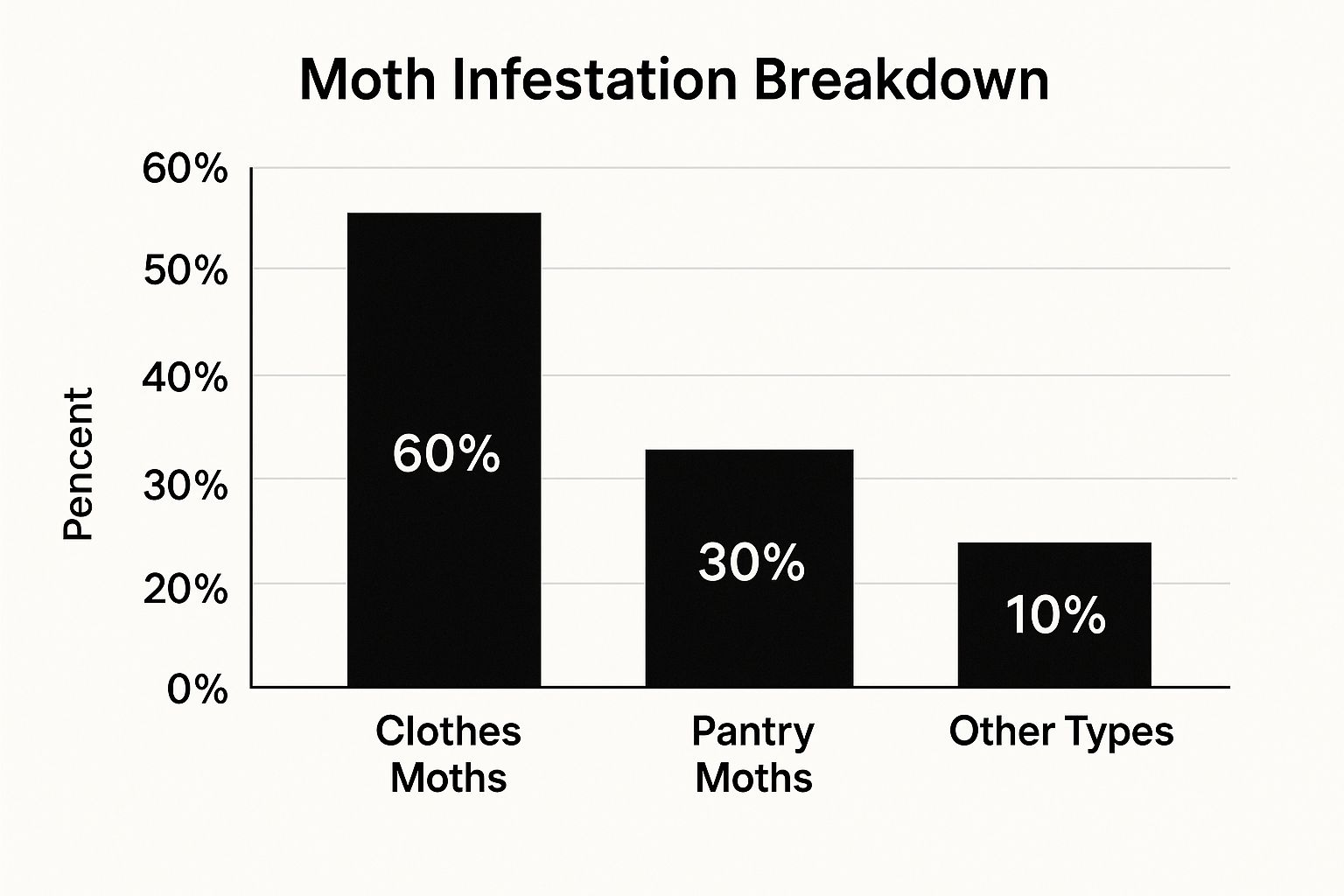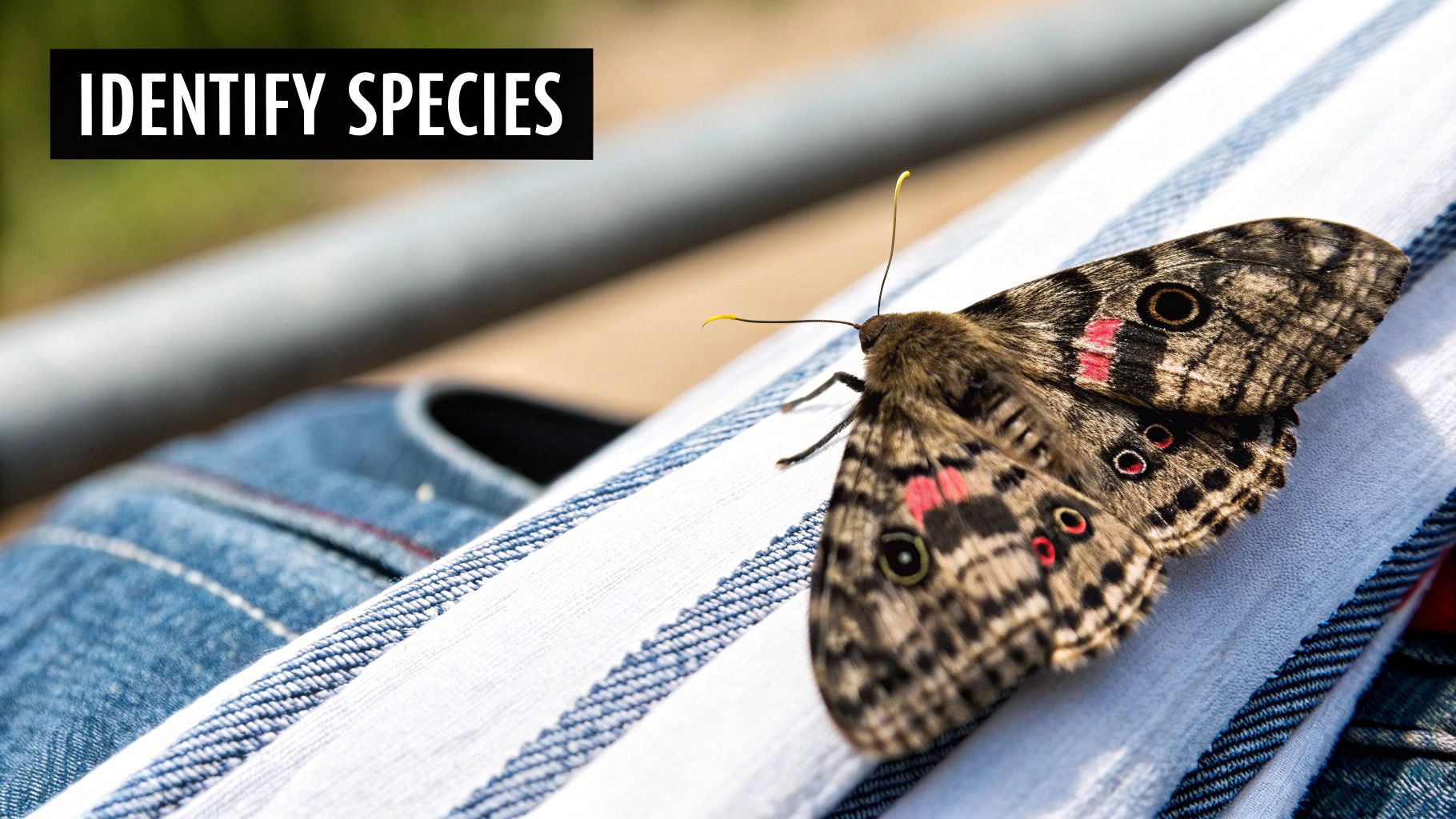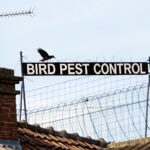Getting a handle on a moth problem starts with two things: figuring out exactly what kind of moth you’re dealing with and acting fast to contain the situation. Whether it’s clothes moths chewing through your favourite jumper or pantry moths making a home in your flour, your first moves will make all the difference. Isolating the infested items is the first, non-negotiable step to stop the spread.
Your First Steps in Moth Treatment
Finding moths in your home is never a welcome discovery, but a calm, methodical approach is your best weapon. The moment you spot a moth, or the tell-tale signs of their larvae, the clock is ticking. The goal here is to stop a small issue from spiralling into a full-blown infestation that demands a much bigger fight. That means you need to identify and isolate, and do it quickly.
The first question you have to answer is, "What kind of moth is this?" It’s not just about satisfying your curiosity; your entire game plan depends on it. Clothes moths and pantry moths are worlds apart in what they eat, where they live, and how they behave. You’ll get absolutely nowhere trying to treat your wardrobe for a pest that’s actually living in your kitchen, and vice versa.
Identify and Isolate Immediately
As soon as you think you have a problem, containment is your next move. Found tiny holes in a wool coat or a bit of silky webbing on a scarf? Get all the surrounding clothes out of there right away. Seal them up in plastic bags or airtight containers. This is a crucial step that stops the larvae from simply crawling over to another expensive item while you figure out your plan of attack.
It's the same story in the kitchen. If you see a moth fluttering about or find webbing in a bag of cereal, it's time for quarantine. Seal up any suspicious food packets—cereals, grains, pet food, dried fruit—in airtight bags and get them out of the cupboard. This simple act of isolation prevents adult moths from laying more eggs and stops the current generation of larvae from ruining any more of your food.
A classic mistake is to just swat the adult moths you see flying around. The real culprits are the larvae, which are almost always hidden away, doing the actual damage. Proper containment means getting the items they're feeding on locked down.
This chart gives you a clear idea of what we typically see in UK homes.

As you can see, clothes moths are by far the most common pest we get called out for, making up the lion's share of household infestations.
To help you get a positive ID, here’s a quick guide to telling the two main culprits apart.
Identifying Common Household Moths
This table offers a quick comparison to help you distinguish between clothes moths and pantry moths based on their appearance, where you find them, and the kind of damage they do.
| Feature | Clothes Moths (Tineola bisselliella) | Pantry Moths (Plodia interpunctella) |
|---|---|---|
| Appearance | Small (around 1cm wingspan), uniformly straw-coloured or golden. | Slightly larger, with distinctive two-toned wings—pale grey near the head and coppery-brown at the tips. |
| Location Found | Dark, undisturbed areas like wardrobes, chests of drawers, and under furniture. | Kitchens, pantries, and any area where dried food is stored. Often seen flying around lights at night. |
| Damage Caused | Irregular holes in natural fibres like wool, silk, cashmere, and fur. Leaves behind fine, silky webbing or tunnels on fabric. | Contaminates food with webbing, cocoons, and faeces. Larvae can chew through cardboard and thin plastic packaging. |
Use this to double-check which unwelcome guest you have, and you'll be on the right track for effective treatment from the get-go.
Identifying and Understanding the Moth Infestation

Dealing with a moth problem effectively goes way beyond swatting the ones you see fluttering around a light. To get rid of them for good, you need to think like a detective. The real issue is happening out of sight, in the dark, undisturbed corners of your home. It’s all about understanding their entire lifecycle, from the egg right through to the destructive larval stage.
That adult moth is just the final, and ironically least harmful, part of the process. The real damage is done by the larvae. They are relentless eating machines with one job: consuming enough protein from your woollens or carbohydrates from your pantry to fuel their transformation. If you only focus on the flying adults, you’re just pulling up weeds without touching the roots – the problem will simply grow back.
Locating the Larvae and Their Damage
To break the cycle, you have to find where the larvae are hiding and feeding. This means getting hands-on and inspecting potential hotspots. Moths don’t just show up for no reason; knowing how you get moths in your house is the first step in figuring out where to look.
For clothes moths, start by carefully examining any garments made from natural fibres. Don't just give them a quick glance. Turn jumpers inside out, check along the seams, and look under collars and lapels.
Key Signs of Clothes Moth Larvae:
- Silky Webbing: You might spot fine, silk-like webbing or tunnels stretched across the surface of fabrics like wool or cashmere. This is a classic sign of the common clothes moth (Tineola bisselliella).
- Cocoons: The casemaking clothes moth (Tinea pellionella) creates tiny, tube-like cases from the very fibres it's eating. These cases, which can look a bit like grains of rice, move with them as they feed.
- Irregular Holes: Moth damage isn’t a clean tear. It typically appears as small, irregular clusters of holes, often in hidden areas of the garment.
In the kitchen, the evidence is different but just as obvious once you know what you're looking for. Pantry moth larvae thrive in stored dry goods and often get into our homes in contaminated products from the shop.
Key Signs of Pantry Moth Larvae:
- Webbing in Food: Finding clumps of webbing in flour, cereal, grains, or even pet food is a dead giveaway. You might also notice it spun along the inside corners of packaging.
- Unpleasant Odour: A serious infestation can create a noticeable musty or oily smell in your cupboards.
- Larvae and Pupae: You may see small, white, caterpillar-like larvae crawling in your food or on the shelves. Look for their cocoons tucked into crevices, on jar lids, or in the corners of your pantry.
Remember, moths love the dark. Your search should be focused on places that are rarely disturbed: the back of the wardrobe, the bottom of a chest of drawers, or that forgotten bag of flour at the very back of the pantry.
Understanding Moth Behaviour and Lifecycle
Moths are creatures of habit, driven entirely by instinct. Adult clothes moths, for example, are surprisingly weak fliers. They much prefer to scuttle into dark crevices rather than fly out into a bright, open room. This is why an infestation can become well-established long before you even realise you have one. They lay their eggs directly onto a food source, making sure their young have a meal ready as soon as they hatch.
The whole lifecycle can take anywhere from a few months to over a year, all depending on conditions like temperature and humidity. The larvae can stay in their destructive feeding stage for months, which explains how a single forgotten jumper can sustain a population for a surprisingly long time.
A single female moth can lay between 40 to 100 eggs in her short life. That reproductive rate is exactly why a fast and thorough approach is so critical. Missing even one small pocket of an infestation gives them the chance to start the cycle all over again, undoing all your hard work. By understanding their behaviour, you can target your treatment efforts precisely where they'll have the biggest impact and finally eliminate the problem at its source.
Natural and Eco-Friendly Moth Control Solutions

If the thought of using chemical sprays in your wardrobe or pantry makes you uneasy, don't worry. There’s a whole arsenal of natural and eco-friendly methods that are incredibly effective at dealing with moths.
These solutions rely on repellents, physical removal, and even a few biological allies to disrupt the moth lifecycle without leaving harsh residues behind. They might require a bit more diligence than a quick spray, but the peace of mind they offer is well worth the effort.
Most people reach for natural repellents first, and for good reason. Certain scents are brilliant at deterring adult moths from settling in and laying their eggs. While these methods won't kill existing larvae, they make your home a far less attractive breeding ground, which is a key part of any solid prevention strategy.
Harnessing Natural Repellents
The classics are classics for a reason: cedar and lavender are two of the best-known natural repellents. The aromatic oils in cedar wood contain compounds that mess with a moth’s ability to navigate and find a suitable spot to lay eggs. Lavender, along with herbs like rosemary and thyme, has a similar deterrent effect.
But to make them work for you, placement is everything.
- Cedar Blocks and Rings: Don't just toss a block into a drawer and hope for the best. Place cedar rings directly onto the hangers of your prized wool coats. Tuck blocks into the corners of wardrobes and drawers, especially where air circulation is poor.
- Lavender Sachets: Small bags of dried lavender can be hung in your wardrobe or placed between folded jumpers. They’re particularly good for protecting delicate items like cashmere.
- Essential Oils: A few drops of cedarwood, lavender, or peppermint oil on cotton balls can be tucked into storage containers or on shelves. Just be careful the oil doesn't directly touch any fabrics, as it can cause staining.
Here’s a crucial tip I’ve learned over the years: these natural oils evaporate. To keep your cedar working, give it a light sanding every few months to expose a fresh, scented layer. Sachets should be gently squeezed to release more fragrance or replaced every season.
Physical Removal and Temperature Control
Beyond scents, some of the most direct and effective treatments involve physically removing the problem and playing with temperature. A thorough cleaning routine is your front-line defence, as it can get rid of eggs and larvae before they even have a chance to hatch and do damage.
Start with a deep vacuum of your wardrobe and pantry. Use the crevice tool to get into every single corner, crack, and shelf joint where eggs might be hiding. Once you're done, immediately dispose of the vacuum bag outside your home to prevent a re-infestation.
Temperature is another powerful, chemical-free weapon in your arsenal. For clothes moths, both extreme cold and heat are lethal. In fact, deep-freezing sealed textiles is now recommended as one of the most effective methods to kill all life stages of moths, a core strategy used in historic houses where moth infestations are a major concern.
To try this at home, seal delicate woollens in a plastic bag and pop them in your freezer for at least 72 hours. For items that can handle it, a gentle cycle in the tumble dryer on a low heat setting can also do the trick. This dual approach helps ensure you eliminate every stage of the moth lifecycle.
Introducing Biological Controls
For a truly advanced and targeted natural solution, you can turn to biological controls. This sounds complicated, but it simply means introducing natural predators that disrupt the moth lifecycle without affecting your home or family in any way. The most common biological agent used for this is the tiny Trichogramma wasp.
These wasps are minuscule—smaller than a pinhead—and completely harmless to humans and pets. Their sole mission is to seek out moth eggs and lay their own eggs inside them, which stops the moth larvae from ever hatching. You can buy them on small cards that you simply place in affected areas like wardrobes or pantries.
Combining these natural strategies creates a robust, multi-layered defence against moths. For more insights on green solutions, check out our full guide on eco-friendly pest control.
Chemical Treatments for Stubborn Infestations
When natural repellents and a good deep clean just aren't cutting it, it might be time to bring in the bigger guns: chemical treatments. I know this step can feel a bit daunting, but using chemical options responsibly is a direct and highly effective way to knock down a stubborn moth population, especially one that’s had time to really dig in.
The trick is to be smart about it. This isn’t about just spraying aimlessly; it’s about a targeted strike that breaks the moth lifecycle where it’s most vulnerable. That way, you’re not only dealing with the adult moths fluttering around but also the hidden larvae that are doing the real damage to your belongings.
Understanding Your Chemical Options
Chemical moth treatments really come in two flavours: those that mess with their behaviour and those that are designed to kill them outright. Pheromone traps are a brilliant example of the first kind. These are basically sticky traps that release a synthetic version of the female moth's mating scent, luring the male moths in and trapping them.
Now, they won't kill the destructive larvae, but they are incredibly useful for a couple of key reasons:
- Monitoring: They give you a crystal-clear picture of how bad the problem is. A trap that fills up fast is a major red flag.
- Disruption: By catching the males, you’re putting a serious dent in the breeding population, which helps to slow the whole infestation down.
Insecticide sprays are your more direct option. Modern formulas often contain active ingredients like transfluthrin or permethrin, which are effective against both the adult moths and their larvae. When you're choosing a spray, it is absolutely crucial to read the label. Some are made specifically for textiles and wardrobes, while others are for cracks and crevices. Never, ever use a general-purpose insecticide in your kitchen pantry.
A classic mistake is to just spray the open areas of a wardrobe. Moth larvae hate the light; they hide in dark, undisturbed spots. For any treatment to work, you have to target the seams of clothes, the corners of drawers, and the little gaps where skirting boards meet the floor.
Safe and Targeted Application
Safety has to be your number one priority here. Before you start, completely empty the area you’re treating, whether it's a wardrobe, a chest of drawers, or a cupboard. This lets you inspect everything properly and makes sure the treatment gets into every potential hiding place.
For clothes moths, apply a fabric-safe insecticide lightly along the seams and folds of your clothes, paying extra attention to anything made of wool, silk, or fur. I always recommend testing the spray on a hidden spot first, just to make sure it doesn't cause any discolouration. Once you're done, let the area ventilate thoroughly before putting anything back. Good airflow is essential to clear out any leftover fumes.
Things get a bit trickier with pantry moths. Food safety is completely non-negotiable. Never spray insecticides directly onto shelves where food is stored. Instead, take all the food out, throw away anything that’s contaminated, and give the area a meticulous vacuum. A targeted crack-and-crevice spray can then be used along shelf joints and in corners, but only after you’ve made sure all food is safely out of the room. Let it dry and air out completely before you restock with fresh food stored in airtight containers.
When to Call a Professional
Let's be honest, sometimes a moth infestation is just too widespread or persistent for DIY methods. If you’ve tried multiple treatments and the moths just keep coming back, or if the problem is affecting valuable items like antique rugs or furniture, it’s time to call in the professionals.
Pest control experts have access to more powerful treatments and specialised equipment that you just can't buy off the shelf. For example, some professional services offer advanced options like heat treatment, which is a fantastic chemical-free solution for wiping out textile pests in an entire room. Knowing when to get professional help for bed bugs and textile pests with heat treatment can save you a huge amount of time, money, and the stress of a problem that just won’t go away. A pro can properly identify the source of the infestation and deliver a solution that guarantees complete eradication.
Preventing Moths from Returning

Getting rid of a moth infestation is a huge relief, but the job isn't quite done. The real victory is making sure they don’t make a comeback. Long-term prevention is all about shifting from a reactive panic to a proactive defence, creating a home where moths simply can't get a foothold.
It means turning vulnerable spots like your wardrobe and pantry into moth-proof fortresses. This isn't about constant, stressful vigilance; it’s about setting up smart habits and storage solutions that do the hard work for you, saving you a lot of hassle and expense down the line.
Rethinking Your Storage Strategy
Honestly, the single most effective thing you can do is create physical barriers that moths and their larvae just can't get through. For both clothes and pantry moths, this comes down to cutting off their access to food by upgrading how you store things.
This is especially true in your wardrobe, particularly for out-of-season clothes. Natural fibres like wool, cashmere, and silk are a five-star buffet for clothes moth larvae, so they need to be properly protected when they're tucked away for months.
- Vacuum-Sealed Bags: These are a game-changer for bulky items like jumpers and coats. Not only do they save a massive amount of space, but they also suck out all the air, making it impossible for larvae to survive.
- Airtight Containers: Sturdy plastic bins with secure, locking lids offer fantastic protection. Just make sure every single item is thoroughly clean before you store it—moths are drawn to tiny food particles and skin cells on worn clothing.
This same logic is absolutely critical in the kitchen. Pantry moth larvae can chew through flimsy cardboard boxes and thin plastic bags with alarming ease. Upgrading your food storage is non-negotiable. Transferring flour, rice, pasta, and cereals into sealed containers immediately cuts off their food supply. To really stop moths from returning, investing in quality solutions like the best glass pantry containers is a crucial step towards keeping your kitchen moth-free for good.
Cultivating a Proactive Cleaning Routine
Moths love dark, dusty, and undisturbed corners. If you regularly disrupt these environments, your home becomes a much less appealing place for them to settle. A consistent cleaning schedule is one of the most powerful tools in your long-term moth prevention arsenal.
Focus your energy on the areas they love most. At least once a season, completely empty your wardrobes and drawers. Get the vacuum out and go over every corner and crevice, paying special attention to where the floor meets the skirting boards. A quick wipe-down of all the surfaces will help remove any microscopic eggs that might be lurking.
The same goes for your kitchen pantry. Regularly clearing out and cleaning your food cupboards stops the build-up of crumbs and food dust that pests find so attractive. It also gives you a chance to inspect your food items for any early signs of trouble, like webbing or larvae, letting you nip a potential problem in the bud.
A proactive mindset is your greatest asset. Think of it like gardening; you don't just pull a weed once and expect it to never return. You cultivate the soil and maintain the environment to favour what you want to grow—and discourage what you don't.
The Bigger Picture of Moth Management
While dealing with household pests is the priority, it's worth remembering the bigger ecological picture. Many moth species are vital pollinators and a key part of the food chain. Responsible pest control means using targeted, appropriate methods inside your home without causing unnecessary harm to the wider environment.
In fact, long-term population studies in the UK have shown a worrying 33% decline in the abundance of larger moths over the last 50 years, which highlights the need for a balanced approach. By using careful prevention strategies at home, you're not just protecting your belongings; you're also managing a pest issue in the most responsible way possible.
Your Moth Treatment Questions Answered
Even with the best plan, it’s completely normal to have questions pop up when you’re dealing with a moth problem. Wondering if you’ve missed a step or if what you’re doing is actually working is all part of the process. Here are some of the most common queries we get, with straightforward answers to help you get the job done right.
Getting a handle on the details—from what larvae can really do to the true purpose of natural repellents—is what separates a temporary fix from a long-term solution.
Can Moths Really Eat Through Plastic Bags?
This is a great question, and the answer is a definite "it depends" on the type of moth.
Pantry moth larvae are surprisingly tough. They have no problem chewing through thin plastic bags, cling film, and flimsy cardboard to get to food. This is exactly why simply rolling down a bag of flour or clipping a cereal box shut won't stop them. It’s also why we always insist on transferring things like grains, cereals, pet food, and spices into properly sealed glass or hard plastic containers. It's a non-negotiable step in preventing an infestation.
Clothes moths, however, can't eat through plastic. Their mouthparts are designed to chew through natural fibres like wool and silk—not synthetics. For them, sealing clothes in thick vacuum bags or airtight bins creates a barrier they simply can’t get through.
How Long Does a Complete Treatment of Moths Take?
The timeline really varies. It all hinges on how bad the infestation is, how far it has spread, and which methods you're using. If you catch a small, isolated problem—like a single contaminated bag of pasta—you could sort it out in an afternoon with a good clean-out.
But for a more established infestation in a wardrobe or across several kitchen cupboards, you need to be more patient. You're not just dealing with the moths you can see; you have to break the entire lifecycle, which can take anywhere from a few weeks to a couple of months. Success means getting rid of the adults, larvae, and the unseen eggs and pupae.
For a moderate infestation, a realistic timeframe is four to six weeks of consistent work. That includes the initial deep clean, applying treatments, and keeping a close eye on things with pheromone traps to make sure no new adults are emerging.
Are Cedar and Lavender Enough to Kill Moths?
This is one of the biggest misconceptions out there. While cedar and lavender are brilliant tools for moth control, they are repellents, not insecticides.
Their strong smells don't kill moths. Instead, they mask the scent of keratin (in wool) or food, which confuses adult moths and makes it harder for them to find a good spot to lay their eggs. They're great for deterring new moths from moving in.
But they won’t do a thing to the larvae that are already munching on your favourite jumper or the eggs waiting to hatch. Think of them as a "No Vacancy" sign for your wardrobe—not an eviction notice. They are best used after you’ve completely dealt with an existing problem.
Why Do I Have Moths Even Though My House Is Clean?
It’s incredibly frustrating to find moths in a spotless home, but it’s important to remember that moths aren't looking for dirt. They're looking for a specific food source and a quiet place to lay eggs. A clean house definitely helps by removing crumbs and dust, but it’s not a forcefield.
Moths can get in a few common ways:
- Flying in from outside: Adult moths can easily come through open doors and windows, especially in warmer weather.
- Hitching a ride: They can be carried in on second-hand furniture, vintage rugs, or even a piece of clothing you picked up from a charity shop.
- Arriving in packaged goods: Pantry moths often start their journey in a warehouse or on a shop shelf, arriving pre-packaged in a sealed bag of flour or box of cereal.
Even the tidiest home can offer the two things moths need to thrive: a food source and a dark, undisturbed corner.
What About Moths Outside My Home?
While we're usually focused on the pests inside, some outdoor moths can become a serious issue and require a totally different strategy.
A prime example is the gypsy moth (Lymantria dispar), which is considered an invasive pest in the UK. Managing this species isn’t about home treatments; it's about large-scale surveillance and early intervention to protect entire woodlands from defoliation. This involves pheromone trapping for monitoring and public reporting to track outbreaks. To see how these larger infestations are tackled, you can find detailed information from UK forestry research services. It's a great reminder that effective pest control always comes down to knowing the specific species you’re up against.
If you’re stuck in a cycle of moth problems or just want to make sure your home is fully protected, don't hesitate to call in the professionals. Pest Predators Limited offers expert, evidence-based solutions to get to the source of the infestation and give you lasting peace of mind.



